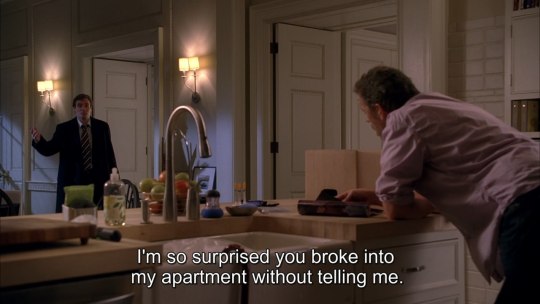#acontextual house
Text










Liners
#acontextual house#house md#gregory house#james wilson#chris taub#robert chase#i cant explain how funny refrigerator line is to me#the outfit chase has on is a great representation of something cruel yet funny#serve king#that's an order#i have to get some sort of reward for putting penis and vagina in the same post... hope it's not a community label#longpost#long post#fuck me i cant decide which long_post tag to drop they're like brothers to me
2K notes
·
View notes
Text
Paul Rudolph-Designed Biggs Residence Is a Piece of Architectural History for Just $1.39M
realtor.com
The Biggs residence at 212 Seabreeze Dr. is one of a few stunning Florida homes designed by architect Paul Rudolph during his Sarasota School of Architecture period.
Listed for $1.8 million last year, it’s now being offered for $1.4 million. Originally completed in 1956, the two-bedroom “laconic battleship-grey steel structure” offered an “austere, symmetrical facade to the street, creating an aggressive, acontextual relationship to the site,” according to author Christopher Domin in “Paul Rudolph: The Florida Houses.”
In less grandiose terms, the home was originally conceived as a big box on stilts.
“The old part of the house is in its original state, with exposed steel beams and perfectly fitted marine-grade wood planks,” says listing agent Linda Lake.
A sketch of the original part of the house
themodernistangle.com
Since its completion, two additions have been made to the home, bringing the total space up to five bedrooms, five bathrooms, and 4,327 square feet.
The first addition was commissioned by Sewell C. Biggs himself, according to Lake, when he realized he needed more space. While the planning for the addition was done by Rudolph, the actual drafting was completed by architect Bob Currie, a friend of Rudolph’s.
By the ocean but in the trees
The Fite Group
The addition required the house to be raised, and the structure is now a FEMA-approved seven-and-a-half feet off the ground, meaning the home qualifies for flood insurance.
The second addition was done by local designer Virginia Courtenay when she lived in the home. “The home was being historically designated at the time,” explains Lake, and Courtenay understood any addition not created by Rudolph would have to look “completely different from what Rudolph designed.��
The resulting tower has a master bedroom and bath, guest bed (or office) and bath, and elevator access.
“It’s interesting because the three [people who worked on the home] were all friends with each other, but from three different generations,” says Lake.
The Biggs residence today
The Fite Group
The home is just a few blocks from the ocean, yet looks out onto the verdant trees. “We understand that Mr. Biggs just loved feeling like he was living in the treetops,” says Lake. While the house is in pretty good shape, it does need a bit of modernization. “It’s a cool place; it’s just a big project,” says Lake.
Some of the exterior needs to be replaced, and the original galley kitchen doesn’t jibe with modern tastes.
“It barely has a freezer, and there’s a tiny refrigerator. One of the drawers won’t open because it can’t get past an appliance,” Lake says with a laugh. Still, she says, the place has huge potential.
“It’s on the market for $1.4 million but could easily go for $3.4 million if someone were to come in and do a really fabulous job on the inside and make the space work better,” she says.
“There are a lot of Paul Rudolph fans out there,” she says, and for the right preservationist, the house is a dream purchase.
If you’re looking to buy a piece of modern architecture history for the price of a suburban McMansion, hop a flight to Delray Beach before the Biggs residence is gone.
The post Paul Rudolph-Designed Biggs Residence Is a Piece of Architectural History for Just $1.39M appeared first on Real Estate News & Insights | realtor.com®.
from https://www.realtor.com/news/unique-homes/paul-rudolph-biggs-residence/
0 notes
Text
Design Charrette
Introduction
Dunelm House (DH) was designed between 1962-64 by the Architects Co-Partnership (ACP). Described as a “delightful huddle” of a building, it clings to the bankside of the River Wear gorge, in the shadow of the famous Durham Cathedral towers, providing weighty counterpoint to the elegant Kingsgate Bridge. However, whilst the bridge is now Grade I listed, its partner, DH, is in a much poorer state of repair, and was recently the subject of an application for Immunity from Listing (COIL) by Durham University. The building is not only a behemoth of new Brutalism and the last remaining Brutalist building of significance in the North East region, but a fine example of contextual modernism and post war University architecture. It was described in an English Heritage report on Durham as “the greatest contribution modern architecture has made to the enjoyment of an English medieval city”.
Following notice of the COIL application, the campaign group Save Dunelm House was formed with the intention of raising awareness about the contribution of this building to the landscape of Durham, and as part of the rich architectural legacy of Durham University. A petition in December 2016 attracted more than 3,000 signatures and buoyed by this success, last year a crowdfunder was organised to fund the campaign to save the building. This design charrette is the first in a series of activities planned, intended to challenge Durham University to recognise DH as an asset with the hope to generate a range of thoughtful, creative, and indeed, viable proposals for how the building could be reconfigured, repaired and imagined differently as part of the future of Durham University.
Who attended, what took place?
There were five teams of nationally acclaimed architects and engineers, including national names such as Levitt Bernstein, Hawkins\Brown and 6a Architects. Smaller practices included Studio Shaw and Newcastle based Mawson Kerr. Engineers from Webb Yates, Skelly and Couch, AKT II and Studio Horn provided the structural, environmental and building services expertise required to make any solutions proposed viable.




Located in one of the rooms overlooking the river, the morning began with an introduction by Save Dunelm House campaign organisers James Perry and Claire Harper. Catherine Croft, director of 20th Century Society then gave an impassioned speech on the importance and consequences of saving DH.Photos of the building upon its completion in 1966, which were shared by the project architect’s wife, Felicity Raines, portrayed a very different DH to the one today. Its original white exposed concrete walls, unencumbered corridors and stairs, beautiful Scandinavian furnishings, minimalist light fittings and Alvar Aalto inspired ceilings, painted a stark contrast to the poorly thought out renovations since. For all who were present, they demonstrated what the building could be again with some care and determination.
Informal tours of DH gave the teams an opportunity to hear first-hand the views of its owners, Durham Students’ Union (DSU), who above all stressed that the building was not fit for purpose. Interestingly, the DSU have been promised by the university that they’ll be given a new building if DH was demolished.
Increasingly throughout the day grew frustrations how Dunelm House had evidently received so little love from its owners and to have fallen into such poor condition.
Proposals and Comments
As the day neared to an end, each team were asked to pin up their proposals and give a five minute presentation to a review panel, which comprised of Catherine Croft from Twentieth Century Society, Graham Farmer as Director of Architecture at Newcastle University, Owen Hatherley from The Guardian and author of Militant Modernism, as well as Ian Rammage, Assistant Director of Estates representing Durham University.A rich range of solutions were proposed, tackling issues of use and adaptability, as well as accessibility, concrete and roof repair and thermal performance.
Levitt Bernstein’s sensitive restoration of DH addressed the practical repair and maintenance of the building fabric and services, with clear and sensible ways to overcome accessibility issues. The lack of a strong vision for DH (repurposing the building as a teaching and conference centre) left the panel unenthused but acknowledged that resolving key practical issues was a great place to start.Second up was the Hawkins\Brown team led by Roger Hawkins who suggested for the building to become “the best hotel in Durham”, a boutique hotel. Overall, the panel appreciated the need for DH to become more outward facing, attracting other visitors and users of the building. However, Owen Hatherley whose greatest delight of the building was the sense of being in a multilayered and cascading set of spaces all the time, felt this would be lost if DH was renovated into hotel rooms.
For 6a Architects, spearheaded by Tim Collett who was the project architect of Newport Street Gallery, there was a desire to return DH to its original social agenda. The scheme proposed a new tower, both to relieve pressure of admin requirements of the building as well as mediating access between the five levels in the building. Though initially appearing acontextual, the tower addition grew on the panel who enjoyed the historical narrative of the scheme.
Newly established London practice Studio Shaw proposed a radical transformation of DH into an outdoor public gardenesque park for a variety of users: students, the local populace and tourists to rest and dwell. An indoor hall for cultural events and concerts was also suggested, by removing the partitions inside DH. At which architectural integrity was raised by the panel.Finally, Mawson Kerr paired with Steve Webb (co-founder of Webb Yates), reimagined a re-use of DH that engaged with the wider community of county Durham; an artisanal training college in partnership with Durham University. The scheme sought to maximise useable floor by providing studio, workshop and exhibition spaces and turn the problem of concrete repair into its own use, a use which Graham Farmer particularly enjoyed as a kind of live experiment.
Maybe unsurprisingly, Ian Rammage from Durham University was unconvinced of each proposal and questioned their viability and use for the university. At the end of discussions, the reason given for the reluctance of the university to reinvest another 50 years into Dunelm House, given the durability of the building thus far, was the contentious issue of flexibility.
Without doubt, pedagogies will continue to change in universities’ context. But as shown in the refurbishment and adaptation of historic buildings, technology has proved time and time again to render any spatial arrangements workable for the twenty-first century.Given the diversity of ingenious and creative ideas proposed in as little as four hours of this design charrette, one can imagine what could be achieved from a more positive and engaged approach from the university.
What next?
The design charrette was, by all measures, a great success in demonstrating that there is great potential for a future Dunelm House – therefore it begs the question; where do we go from here? It could be argued that the greatest challenge to overcome, before any actual redesign of DH can take place, is that of changing its perception by Durham University from a cumbersome problem to a valuable asset. It’s precisely this concept of ‘value’ which needs to be assessed beyond the pure aesthetic function of the building, but also its place within the historic built fabric of Durham. As has been the case throughout history for many building typologies, not just brutalism, the tide of what the general public’s impression of what is (or isn’t) aesthetically fashionable is often what can condemn a building to an early grave. This factor can’t be disregarded, especially in the case of increasingly competitive, business-like universities, as a well-defined campus ‘image’ can help attract the best students from all over the globe. However, aesthetic fashions weave in and out of history, as can clearly be seen by the clearing of swathes of Victorian building in the early post-war period, only to be missed once their architectural merit was realised post-demolition. Brutalism’s own merits in radical, socio-political ethics and design capture a pivotal moment in our built history and, with DH as a prime example, it too will undoubtedly be missed if it is lost. The question is, how to change public opinion before it is too late? Perhaps the catalyst of this change could stem from activating the student body who, in this age of education with ever increasingly business-like structures, hold more sway than they realise. The current interior, originally designed as a series of different sized social activity spaces, is currently occupied largely by admin and assorted storage. Conceivably, increasing awareness that these spaces are being misused and allowing students to take advantage of their building would allow memories and narratives to attach themselves to the building. Or possibly it is a problem of the wider public’s education of architecture itself? Maybe a greater understanding of the significance in history of the socio-political ethics in Brutalist design would encourage activism to save these buildings? Then, in the case of DH, could an affection for both this unique socially motivated, deeply contextual design galvanise the public into action? Whatever the case, it appears a fundamental question needs to be asked of where to find architecture’s value. Is it embedded at the surface level of aesthetics, or does it go deeper, intertwined with its ability to function, its specific moment in history and socio-political motivation?
0 notes
Text
Paul Rudolph-Designed Biggs Residence Is a Piece of Architectural History for Just $1.39M
realtor.com
The Biggs residence at 212 Seabreeze Dr. is one of a few stunning Florida homes designed by architect Paul Rudolph during his Sarasota School of Architecture period.
Listed for $1.8 million last year, it’s now being offered for $1.4 million. Originally completed in 1956, the two-bedroom “laconic battleship-grey steel structure” offered an “austere, symmetrical facade to the street, creating an aggressive, acontextual relationship to the site,” according to author Christopher Domin in “Paul Rudolph: The Florida Houses.”
In less grandiose terms, the home was originally conceived as a big box on stilts.
“The old part of the house is in its original state, with exposed steel beams and perfectly fitted marine-grade wood planks,” says listing agent Linda Lake.
A sketch of the original part of the house
themodernistangle.com
Since its completion, two additions have been made to the home, bringing the total space up to five bedrooms, five bathrooms, and 4,327 square feet.
The first addition was commissioned by Sewell C. Biggs himself, according to Lake, when he realized he needed more space. While the planning for the addition was done by Rudolph, the actual drafting was completed by architect Bob Currie, a friend of Rudolph’s.
By the ocean but in the trees
The Fite Group
The addition required the house to be raised, and the structure is now a FEMA-approved seven-and-a-half feet off the ground, meaning the home qualifies for flood insurance.
The second addition was done by local designer Virginia Courtenay when she lived in the home. “The home was being historically designated at the time,” explains Lake, and Courtenay understood any addition not created by Rudolph would have to look “completely different from what Rudolph designed.”
The resulting tower has a master bedroom and bath, guest bed (or office) and bath, and elevator access.
“It’s interesting because the three [people who worked on the home] were all friends with each other, but from three different generations,” says Lake.
The Biggs residence today
The Fite Group
The home is just a few blocks from the ocean, yet looks out onto the verdant trees. “We understand that Mr. Biggs just loved feeling like he was living in the treetops,” says Lake. While the house is in pretty good shape, it does need a bit of modernization. “It’s a cool place; it’s just a big project,” says Lake.
Some of the exterior needs to be replaced, and the original galley kitchen doesn’t jibe with modern tastes.
“It barely has a freezer, and there’s a tiny refrigerator. One of the drawers won’t open because it can’t get past an appliance,” Lake says with a laugh. Still, she says, the place has huge potential.
“It’s on the market for $1.4 million but could easily go for $3.4 million if someone were to come in and do a really fabulous job on the inside and make the space work better,” she says.
“There are a lot of Paul Rudolph fans out there,” she says, and for the right preservationist, the house is a dream purchase.
If you’re looking to buy a piece of modern architecture history for the price of a suburban McMansion, hop a flight to Delray Beach before the Biggs residence is gone.
The post Paul Rudolph-Designed Biggs Residence Is a Piece of Architectural History for Just $1.39M appeared first on Real Estate News & Insights | realtor.com®.
from DIYS http://ift.tt/2CjXcqp
0 notes
Text
"Zaha Hadid Architects is a lot more successful when more restrained"
Are the designs for a "restrained" Beijing skyscraper a step in the right direction for Zaha Hadid Architects? In this week's comments update, readers are claiming the firm is better when it tones down the curves.
Heydar not heyday: readers are praising designs for a 207-metre skyscraper by Zaha Hadid Architects in Beijing, which will feature a huge twisting atrium that is expected to be the world's tallest.
"ZHA is a lot more successful when they're more restrained, as in this project," wrote Jon.
"The best Zaha by far," agreed Guest. "A truly impressive piece of architecture and art."
"Impressive renderings, excellent design, atypically restrained on ZHA's part," said HeywoodFloyd. "I much prefer this to their typical acontextual Heydar Aliyev parametric bombast mode."
But some readers were concerned about the practicality of a building that boasts a 90-metre-high void:
Read the comments on this story ›
Photography courtesy of Global Panorama
Fight the right: Anish Kapoor and Wolfgang Tillmans are among artists forming a coalition against the "rise of right-wing populism" – but readers are doubting whether their message will resonate with the general public.
"Will the postmodern cultural elite ever get over using all this fluff language that pretends to be so meaningful in order to cover up its lack of meaning?" asked Derek.
"I think these are goals worth supporting but they are rather threatened by global capitalism than right-wing populism, which is to a certain extent a reaction to the former," wrote Werner.
"Certainly a worthwhile cause, but unfortunately it's hard to imagine the message will escape from the echo chamber," wrote Dan.
Kapoor's exclusive ownership of a paint colour dubbed the "world's blackest black" came back to haunt him:
Read the comments on this story ›
Photograph by Ossipvan Duivenbode
Wearing thin: this skinny house in Rotterdam designed by an architect couple for themselves was our most-read story of last week, but some commenters are starting to suffer from plywood fatigue.
"Surprisingly prosaic for a couple of cool architects," wrote Guest. "And that plywood again."
"I quite like it overall, although this plywood trend HAS to die soon," concurred Manu.
One reader stressed that ticking all the boxes isn't always a good thing:
Read the comments on this story ›
Mind the pay gap: a debate on sexism in the architecture profession broke out in our comments section, following Santiago Calatrava's claims that female architects should "just wait a second" for pay equality.
"If his remarks are not sexist, I don't know what is. He must be setting himself up to be architect for Donald Trump's Presidential Library!" said Dale.
"What a privileged bunch of remarks," said TFO.
But some readers dismissed the concept of a pay gap, arguing that it is down to women to negotiate a better salary.
"Women shouldn't wait to get equal pay, they should just not accept lower wages if they don't want to work for that amount," said regular commenter H-J.
Berklyn responded, calling commenters out on what she described as "victim-blaming":
Read the comments on this story ›
Related story
Zaha Hadid Architects' Beijing tower to feature world's largest atrium
The post "Zaha Hadid Architects is a lot more successful when more restrained" appeared first on Dezeen.
from RSSMix.com Mix ID 8217598 https://www.dezeen.com/2017/02/21/comments-update-dezeen-zaha-hadid-architects-beijing-skyscraper-anish-kapoor-skinny-house-rotterdam-santiago-calatrava/
0 notes
Text
"Zaha Hadid Architects is a lot more successful when more restrained"
Are the designs for a "restrained" Beijing skyscraper a step in the right direction for Zaha Hadid Architects? In this week's comments update, readers are claiming the firm is better when it tones down the curves.
Heydar not heyday: readers are praising designs for a 207-metre skyscraper by Zaha Hadid Architects in Beijing, which will feature a huge twisting atrium that is expected to be the world's tallest.
"ZHA is a lot more successful when they're more restrained, as in this project," wrote Jon.
"The best Zaha by far," agreed Guest. "A truly impressive piece of architecture and art."
"Impressive renderings, excellent design, atypically restrained on ZHA's part," said HeywoodFloyd. "I much prefer this to their typical acontextual Heydar Aliyev parametric bombast mode."
But some readers were concerned about the practicality of a building that boasts a 90-metre-high void:
Read the comments on this story ›
Photography courtesy of Global Panorama
Fight the right: Anish Kapoor and Wolfgang Tillmans are among artists forming a coalition against the "rise of right-wing populism" – but readers are doubting whether their message will resonate with the general public.
"Will the postmodern cultural elite ever get over using all this fluff language that pretends to be so meaningful in order to cover up its lack of meaning?" asked Derek.
"I think these are goals worth supporting but they are rather threatened by global capitalism than right-wing populism, which is to a certain extent a reaction to the former," wrote Werner.
"Certainly a worthwhile cause, but unfortunately it's hard to imagine the message will escape from the echo chamber," wrote Dan.
Kapoor's exclusive ownership of a paint colour dubbed the "world's blackest black" came back to haunt him:
Read the comments on this story ›
Photograph by Ossipvan Duivenbode
Wearing thin: this skinny house in Rotterdam designed by an architect couple for themselves was our most-read story of last week, but some commenters are starting to suffer from plywood fatigue.
"Surprisingly prosaic for a couple of cool architects," wrote Guest. "And that plywood again."
"I quite like it overall, although this plywood trend HAS to die soon," concurred Manu.
One reader stressed that ticking all the boxes isn't always a good thing:
Read the comments on this story ›
Mind the pay gap: a debate on sexism in the architecture profession broke out in our comments section, following Santiago Calatrava's claims that female architects should "just wait a second" for pay equality.
"If his remarks are not sexist, I don't know what is. He must be setting himself up to be architect for Donald Trump's Presidential Library!" said Dale.
"What a privileged bunch of remarks," said TFO.
But some readers dismissed the concept of a pay gap, arguing that it is down to women to negotiate a better salary.
"Women shouldn't wait to get equal pay, they should just not accept lower wages if they don't want to work for that amount," said regular commenter H-J.
Berklyn responded, calling commenters out on what she described as "victim-blaming":
Read the comments on this story ›
Related story
Zaha Hadid Architects' Beijing tower to feature world's largest atrium
The post "Zaha Hadid Architects is a lot more successful when more restrained" appeared first on Dezeen.
from ifttt-furniture https://www.dezeen.com/2017/02/21/comments-update-dezeen-zaha-hadid-architects-beijing-skyscraper-anish-kapoor-skinny-house-rotterdam-santiago-calatrava/
0 notes
Text










One liners the sequel
#acontextual house#house md#gregory house#james wilson#thirteen#remy hadley#robert chase#“irene adler” fucking killed me first time I heard it#Wilson you're fucking asshole lmao#now did he made up a name or the Sherlock series existence is canon#but ducklings didn't seem to catch on to the reference so its prob random#or was it losely based on someone real who house knew and who did “win” like irene in sherlock did#the fact that this is wilson (watson) telling (making up) us the story of irene is very neat adaptation move to me#is it even adaptation lol. just a reference I guess#anyway#still i laughed at that line#and whats in the porntitle is “Making room for Daddy's hot bisexual with boyfriend problems.”#ridiculous#applies to them both#long post#longpost
2K notes
·
View notes
Text










Some Lines from A Show
#house md#gregory house#james wilson#amber volakis#chris taub#eric foreman#robert chase#acontextual house#“reading people or buildings” okay..... house#you have no clue how long I've been coming back to that one#i consent you consent but does mom and Shakira?!?#solid advice from wilson aka mr. well-adjusted#long post#longpost
974 notes
·
View notes
Text










Random one liners
#acontextual house#house md#gregory house#james wilson#lisa cuddy#eric foremen#alison cameron#robert chase#trust me context doesn't make it better
1K notes
·
View notes
Text










——–---Lines---–——
#house md#acontextual house#gregory house#james wilson#okay yeah I'm making it seem like House killed someone for having house and on parole for it yeah#he loves goat cheese :)#its the [Chuckles] that gets me#long post#longpost
407 notes
·
View notes
Text










Context, who needs her?
#acontextual house#house md#gregory house#eric foremen#james wilson#amber volakis#chris taub#riding that Cameron's dead husband sperm thing for all it has#the meltdown pose with wilson friend line is just immaculate
629 notes
·
View notes
Text










lines?
#house md#james wilson#gregory house#bonnie wilson#chris taub#lawrence kutner#remy hadley#thirteen#13#eric foreman#acontextual house#guess whos down to dig up a body without a court order lolol#used “the cat was right house” as a screensaver for a day and lost it every time#longpost#long post
187 notes
·
View notes
Text










-Lines-
#house md#gregory house#james wilson#martha masters#robert chase#acontextual house#<- tag for out of context batches#many crimes of obama in house md universe none of which are related to medicine#the glee on the roomated line
200 notes
·
View notes
Text










One liners the -quel
#acontextual house#house md#gregory house#james wilson#13#remy hadley#eric foremen#chris taub#true dat#long post#longpost
398 notes
·
View notes
Text










lines
#acontextual house#house md#gregory house#robert chase#james wilson#sam carr#chicken is there too#“and lose $20?” my beloved#hugh laurie mocking british accent is my favorite thing#only rivaled by him doing french one
185 notes
·
View notes
Text










What a nice guy :)
#house md#gregory house#you can still tell he's sarcastic in like half of these#but i tried my best to assemble this propaganda#what for? idk#lying for fun kind of day#screencap#actually he's sincere in like 1 of these#2 if we count Garfield#acontextual house
246 notes
·
View notes